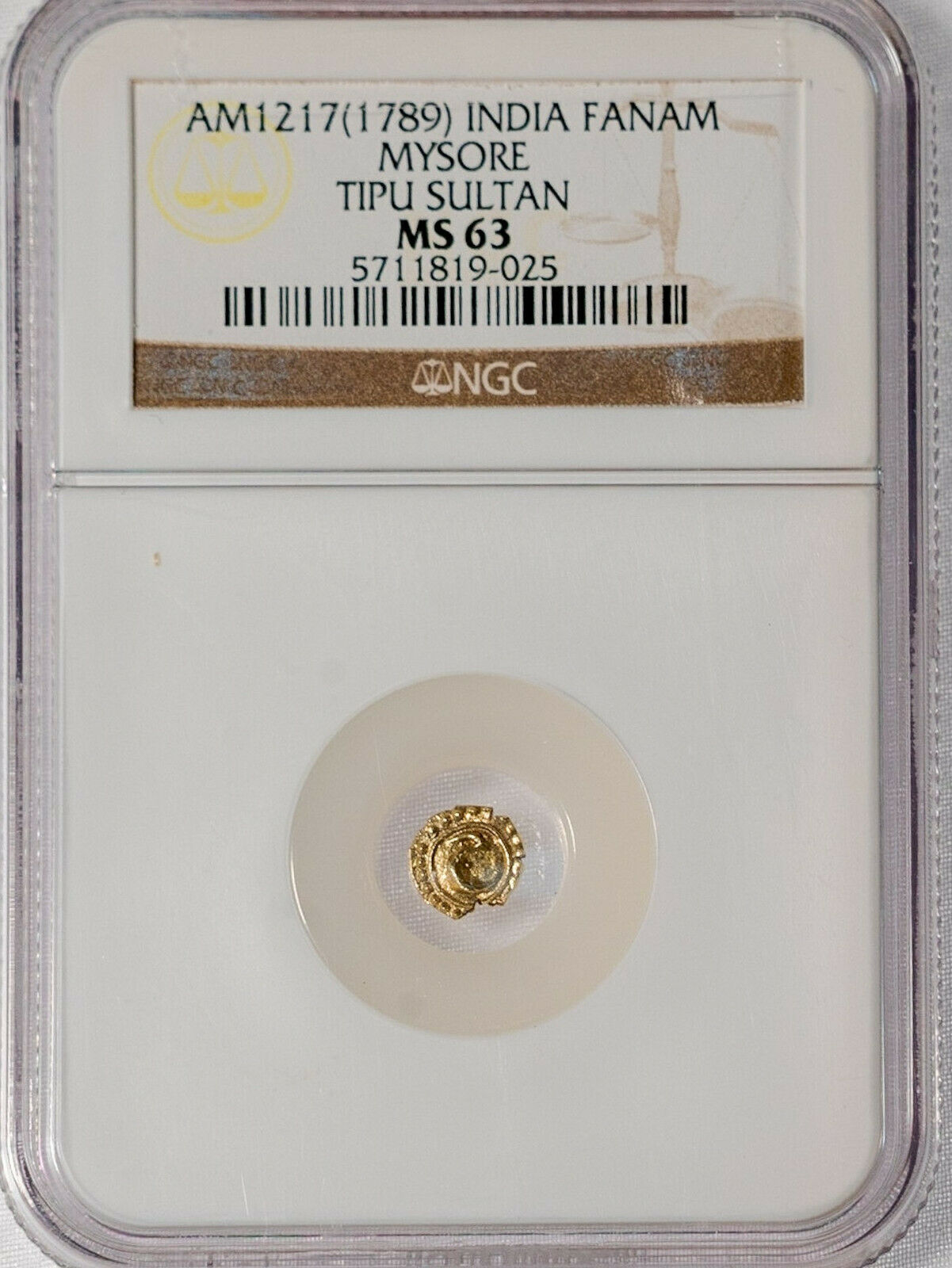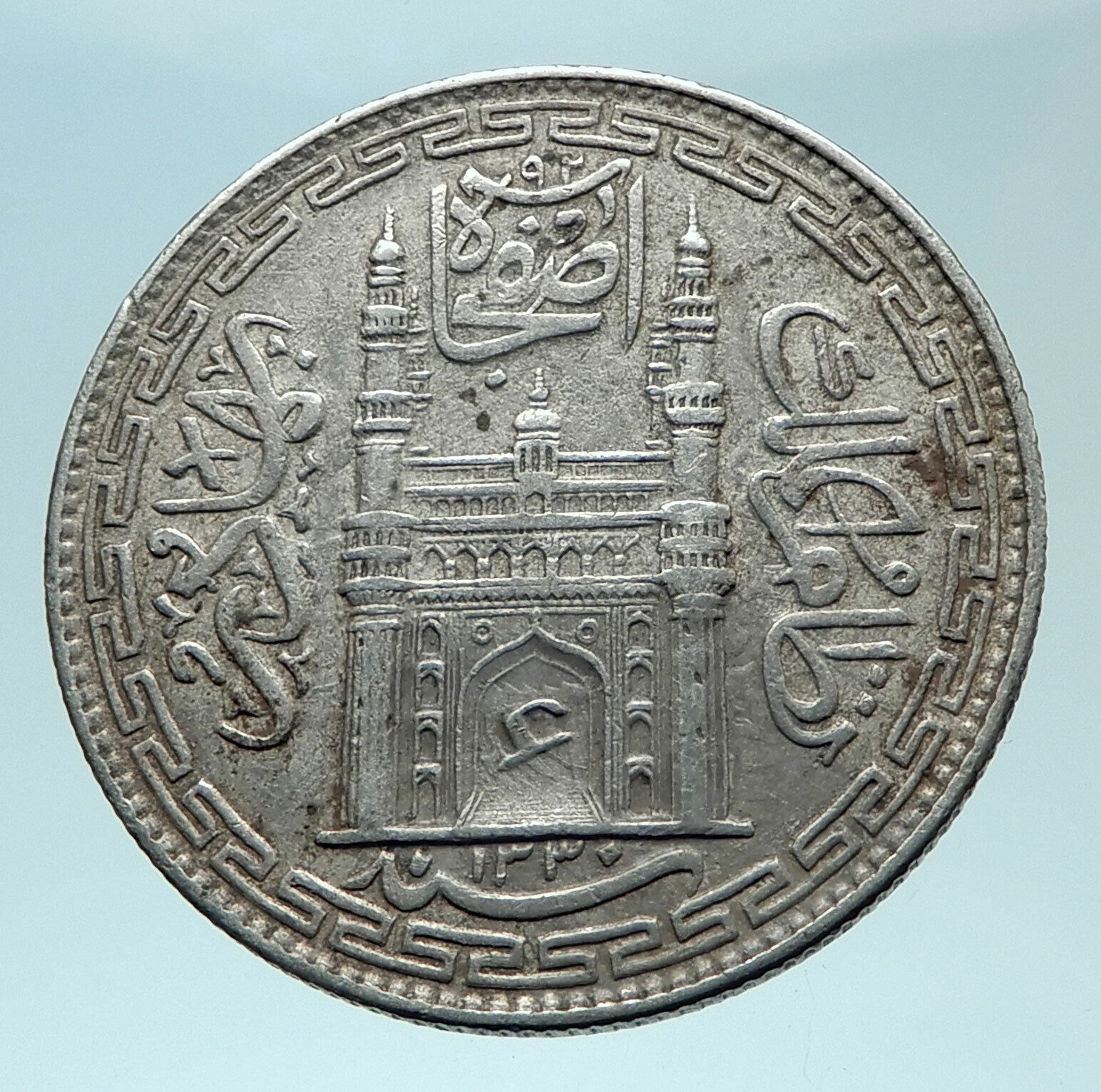-40%
India, Mysore Tipu Sultan Gold Fanam 1789 NGC MS63, Bright and Well Struck !
$ 64.94
- Description
- Size Guide
Description
Indian State, Mysore, Tipu Sultan Gold Fanam,AM 1217 (1789), Patan Mint, KM128.1.
Graded NGC MS63, Census [4/7], total of 11. Scarce in this grade.
Excellent strike and bright mint luster.
Combined shipping available. Please view our high resolution photos.
Mysore (/maɪˈsɔːr/ ), officially Mysuru ([ˈmaɪ'suːɾu] ), is a city in the southern part of the state of Karnataka, India. Mysore city is geographically located between 12° 18′ 26″ north latitude and 76° 38′ 59″ east longitude. It is located at an altitude of 740 m (2,427 ft).
Mysore is located in the foothills of the Chamundi Hills about 145.2 km (90 mi) towards the southwest of Bangalore and spread across an area of 286.05 km2 (110 sq mi). Mysore City Corporation is responsible for the civic administration of the city, which is also the headquarters of the Mysore district and the Mysore division. In November 2020, A gazetted notification was passed by the state government converting nearby census town of Hootagalli into a City Municipal Council along with four more Town Panchayats of Bhogadi, Kadakola, Rammanahalli and Srirampura, expanding the city area from 155.7 sq.km to 286.05 sq.km. This also increased the population of the urban agglomeration from 990,900 to 1,060,120. According to United Nations, Mysuru is projected to have a population of 1.162 Million in 2018, making it the second largest city in the state.
It served as the capital city of the Kingdom of Mysore for nearly six centuries from 1399 until 1956. The Kingdom was ruled by the Wadiyar dynasty, with a brief period of interregnum in the late 18th century when Hyder Ali and Tipu Sultan were in power. The Wadiyars were patrons of art and culture. Tipu Sultan and Hyder Ali also contributed significantly to the cultural and economic growth of the city and the state by planting mulberry trees introducing silk in the region and fighting 4 Anglo-Mysore wars against the British. The cultural ambience and achievements of Mysore earned it the sobriquet Cultural Capital of Karnataka.
Mysore is noted for its heritage structures and palaces, including the Mysore Palace, and for the festivities that take place during the Dasara festival when the city receives many tourists from around the world. It lends its name to various art forms and culture, such as Mysore Dasara, Mysore painting; the sweet dish Mysore Pak, Mysore Masala Dosa; brands such as Mysore Sandal Soap, Mysore Ink; and styles and cosmetics such as Mysore Peta (a traditional silk turban) and the Mysore silk saris. Mysore is also known for its special variety of jasmine flower fondly referred as "Mysore Mallige" and betel leaves. Tourism is the major industry alongside the traditional industries. Mysore's inter-city public transportation includes rail, bus and flights.
Etymology
The name Mysore is an anglicised version of Mahishūru, which means the abode of Mahisha in the vernacular Kannada. The common noun Mahisha, in Sanskrit, means buffalo; in this context, however, Mahisha refers to Mahishasura, a mythical demon who could assume the form of both human and buffalo, who, according to Hindu mythology, ruled the ancient parts of Mysore Kingdom, known in Sanskrit as Mahíšhaka, centred at Mahishapura. He was killed by the Goddess Chamundeshwari, whose temple is situated atop the Chamundi Hills, after whom it is named. 'Mahishapura' later became Mahisūru (a name which, even now, the royal family uses), and finally came to be anglicised as Mysore by the British and Maisūru/Mysuru in the vernacular Kannada language.
In December 2005, the Government of Karnataka announced its intention to change the English name of the city to Mysuru. This was approved by the Government of India in October 2014 and Mysore was renamed (along with twelve other cities) to "Mysuru" on 1 November 2014.
History
The site where Mysore Palace now stands was occupied by a village named Puragere at the beginning of the 16th century. The Mahishūru Fort was constructed in 1524 by Chamaraja Wodeyar III (1513–1553), who passed on the dominion of Puragere to his son Chamaraja Wodeyar IV (1572–1576). Since the 16th century, the name of Mahishūru has commonly been used to denote the city. The Mysore Kingdom, governed by the Wodeyar family, initially served as a vassal state of the Vijayanagara Empire. With the decline of the Vijayanagara Empire after the Battle of Talikota in 1565, the Mysore Kingdom gradually achieved independence, and by the time of King Narasaraja Wodeyar (1637) it had become a sovereign state. Seringapatam (modern-day Srirangapatna), near Mysore, was the capital of the kingdom from 1610. The 17th century saw a steady expansion of its territory and, under Narasaraja Wodeyar I and Chikka Devaraja Wodeyar, the kingdom annexed large expanses of what is now southern Karnataka and parts of Tamil Nadu, to become a powerful state in the southern Deccan.
The kingdom reached the height of its military power and dominion in the latter half of the 18th century under the de facto rulers Hyder Ali and his son Tipu Sultan. The latter demolished parts of Mysore to remove legacies of the Wodeyar dynasty. During this time, Mysore kingdom came into conflict with the Marathas, the British and the Nizam of Golconda, leading to the four Anglo-Mysore wars, success in the first two of which was followed by defeat in the third and fourth. After Tipu Sultan's death in the Fourth Anglo-Mysore War in 1799, the capital of the kingdom was moved back to Mysore from Seringapatam, and the kingdom was distributed by the British to their allies of the Fourth Mysore war. The landlocked interior of the previous Mysore Kingdom was turned into a princely state under the suzerainty of the British Crown. The former Wodeyar rulers were reinstated as puppet monarchs, now styled Maharajas. The British administration was assisted locally by Diwan (chief minister) Purnaiah. Purnaiah is credited with improving Mysore's public works. Mysore lost its status as the administrative centre of the kingdom in 1831, when the British commissioner moved the capital to Bangalore. It regained that status in 1881 and remained the capital of the Princely State of Mysore within the British Indian Empire until India became independent in 1947.
The Mysore municipality was established in 1888 and the city was divided into eight wards. In 1897 an outbreak of bubonic plague killed nearly half of the population of the city. With the establishment of the City Improvement Trust Board (CITB) in 1903, Mysore became one of the first cities in Asia to undertake planned development of the city. Public demonstrations and meetings were held there during the Quit India movement and other phases of the Indian independence movement.
After Indian Independence, Mysore city remained as part of the Mysore State, now known as Karnataka. Jayachamarajendra Wodeyar, then king of Mysore, was allowed to retain his titles and was nominated as the Rajapramukh (appointed governor) of the state. He died in September 1974 and was cremated in Mysore city. Over the years, Mysore became well known as a centre for tourism; the city remained largely peaceful, except for occasional riots related to the Kaveri River Water Dispute. Among the events that took place in Mysore and made national headlines were a fire at a television studio that claimed 62 lives in 1989, and the sudden deaths of many animals at the Mysore Zoo.













